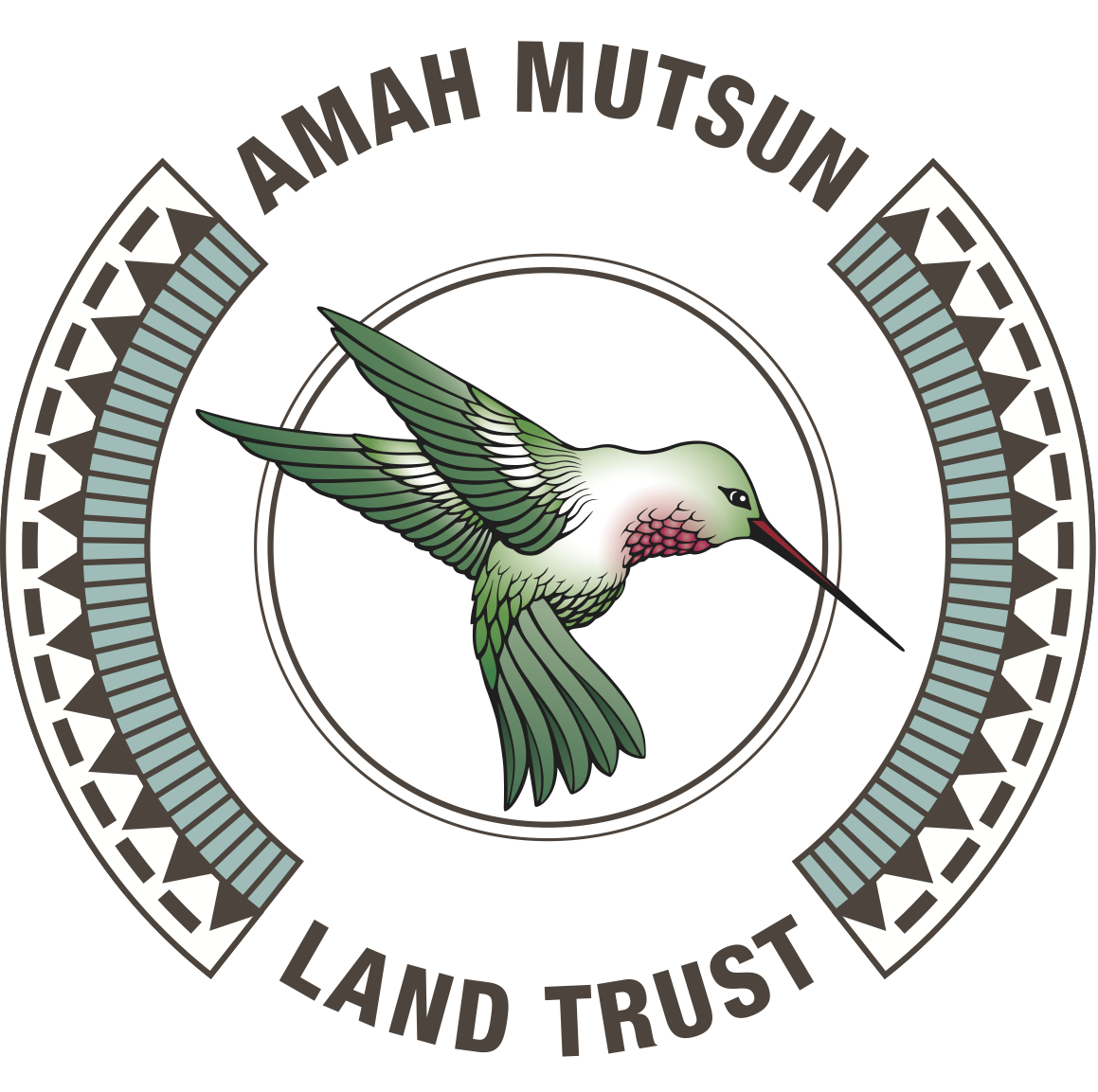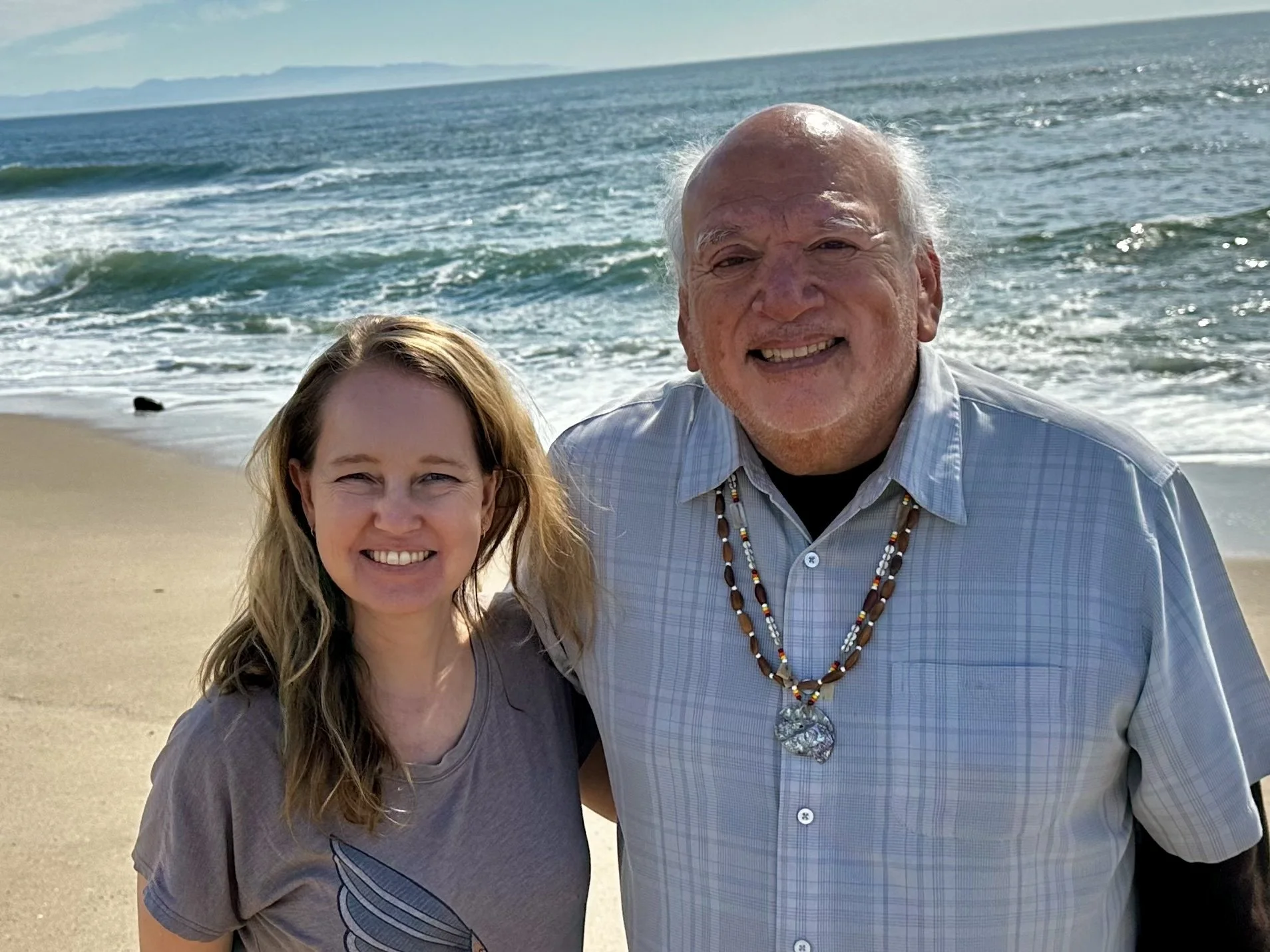Spring 2025 Newsletter
To return to the newsletter, click here.
Get to know AMLT’s new Executive Director:
Q&A with Noelle Chambers
We are thrilled to announce that last month, AMLT hired Noelle Chambers as our next Executive Director. Noelle has dedicated her career to land protection and stewardship, and brings two decades of experience in land transactions. Noelle previously worked for Peninsula Open Space Trust (POST) for 20 years in a variety of positions, including 5 years as Vice President of Conservation. Her tenure at POST has included the successful protection and transfer of over 30,000 acres for long-term conservation and stewardship, including the acquisition of Pescadero Ranch, which is part of the greater Juristac cultural landscape.
Noelle Chambers and Chairman Valentin Lopez celebrate Noelle’s hire in Santa Cruz, CA.
Chairman Valentin Lopez, who has personally known Noelle for over 15 years, said: “Noelle is a proven leader who has been successful in all areas of land conservation and protection. I have no doubt that she understands the importance of Indigenous science, has great respect for our Mutsun culture and understands the importance of healing for both our Tribe and non-Tribal institutions and communities. I can’t think of a better person to lead our Land Trust at this time.”
Outside of her land protection work, Noelle is a person deeply passionate about and committed to the interconnected healing of nature and people. In the interview below, you will have the chance to get to know Noelle, what brings her to AMLT at this time, and the dreams she hopes to realize in the future.
What brings you to AMLT at this time? How do you feel being selected as AMLT’s next Executive Director?
I’ve been fortunate to develop a partnership with AMLT through my work at POST, and I believe that the work of restoring Indigenous stewardship to the land is more urgent than ever. I’m inspired by the vision, leadership, and dedication of the Amah Mutsun Tribal Band and Land Trust, and I am humbled by their trust in me to lead AMLT. Given that I am not a Tribal member, I am especially honored to step into this role.
When were you first introduced to AMLT?
I met Chairman Lopez before AMLT was officially formed and had the privilege of partnering alongside AMLT on numerous occasions through my aligned work at POST. I’ve witnessed the Land Trust’s impact grow over time, showing what’s possible when Indigenous knowledge leads conservation efforts.
Could you share a bit with us about your career thus far in land protection and conservation?
I studied ecology in college with a minor in anthropology, and I was drawn to the impactful on-the-ground conservation work of land trusts. After working for a land trust in Pennsylvania for a couple years after grad school, I was happy to move back to the Bay Area where I grew up to take a job at POST.
I was at POST for exactly twenty years where I focused on land protection, restoration, and stewardship to safeguard biodiversity, build climate resilience, and ensure equitable access to nature. Throughout my work, I’ve been guided by the belief that conservation must be rooted in relationships - with the land, with communities, and with the original stewards of these landscapes.
I’ve been fortunate to work on a number of impactful projects during my time at POST, including leading the POST team last fall in the acquisition of Pescadero Ranch in Santa Cruz County, adjacent to Sargent Ranch and a portion of the Juristac Tribal Cultural Landscape. I had the honor of touring the property with Chairman Lopez on the first official visit for the Amah Mutsun following POST’s acquisition, and I look forward to working on behalf of AMLT to continue the partnership with POST.
Based on your experience, where do you see the Land Trust going in the next 3-5 years?
There are exciting near-term opportunities for AMLT to acquire properties and increase stewardship, with an integrated approach to stewardship that includes cultural burning, native plant propagation, and restoration of land and waterways. AMLT is reenergizing the Native Stewardship Corps to focus on cultural learning and skill-building, and AMLT will continue to focus on cultural resources by conducting archeological monitoring and building Tribal community knowledge. In addition, a large part of my efforts will be to ensure that AMLT’s work is resourced for the long term.
I also see AMLT’s model continuing to inspire a broader movement, one that recognizes the essential role of Tribal stewardship in addressing climate change, restoring ecosystems, and healing relationships with the land.
What dreams do you have for AMLT? What dreams do you have for the world?
My dreams for AMLT include cultivating a strong, enduring organization that ensures the Amah Mutsun Tribal Band can care for its homelands for generations to come. By securing land and restoring Indigenous stewardship, AMLT will help bring the Tribe’s vision to life - a future where waters run clean, wildlife thrives, ceremonies are held in sacred places, and the land and people are in balance once again.
For the world, I dream that all communities recognize their responsibility to care for the places that sustain them. I envision a future in which humanity remembers that we are not separate from nature but part of it, and where our relationship with the earth is based not on extraction but on respect, stewardship, and gratitude.
What has been your experience learning about Indigenous stewardship? How did your learning change the way you understood nature and conservation, if at all?
It has been incredibly powerful to learn from various Indigenous leaders and knowledge holders through various experiences, and I have learned so much from Chairman Lopez over the years. I’ve had to unlearn much of my formal conservation training, which was rooted in a Western framework that often viewed nature as separate from people. Over time, I came to understand that this separation is the very reason that conservation is needed in the first place. Indigenous stewardship teaches us that people are part of the land’s story and that caring for the land is also about reciprocity, responsibility, and relationship. This understanding has changed the way I approach conservation, centering Indigenous leadership and traditional ecological knowledge in efforts to heal landscapes.
How do you personally enjoy and interact with the natural world, outside of work?
Being outside is how I reset and connect with the world around me. I enjoy many forms of connecting with nature, whether hiking through redwood forests, exploring tidepools, or sitting quietly in a grove of oak trees. I also love to be outside with my two teenagers, particularly spending time at the beach together.
What is your favorite native plant and why?
It’s impossible to pick a favorite but I’ll go with the coast live oak. Oaks are vitally important for the ecosystem, supporting countless other beings, and they remind me of resilience, generosity, and deep-rooted connections. I love the way they twist and stretch their branches, forming sheltering canopies that feel like a world unto themselves. Plus, it has significant cultural value for Indigenous people.
What do you like to do in your free time?
I enjoy spending time with my kids, being in nature, reading, practicing yoga, listening to music, and playing with my dog and my cat.
If you asked your previous team at POST to describe you in three words, what would they say?
Dedicated, caring, and reliable
Do you have any book recommendations?
I love to share book recommendations! I always recommend Braiding Sweetgrass by Robin Wall Kimmerer because it is a beautifully written articulation of weaving Western science with Indigenous ways of knowing towards a more sustainable world.I also highly recommend Entangled Life by Merlin Sheldrake about the fascinating world of fungi. Some of my all-time favorite books are House of Spirits by Isabel Allende and Animal Dreams by Barbara Kingsolver, and I’ve enjoyed everything I’ve read by Louise Erdich.

